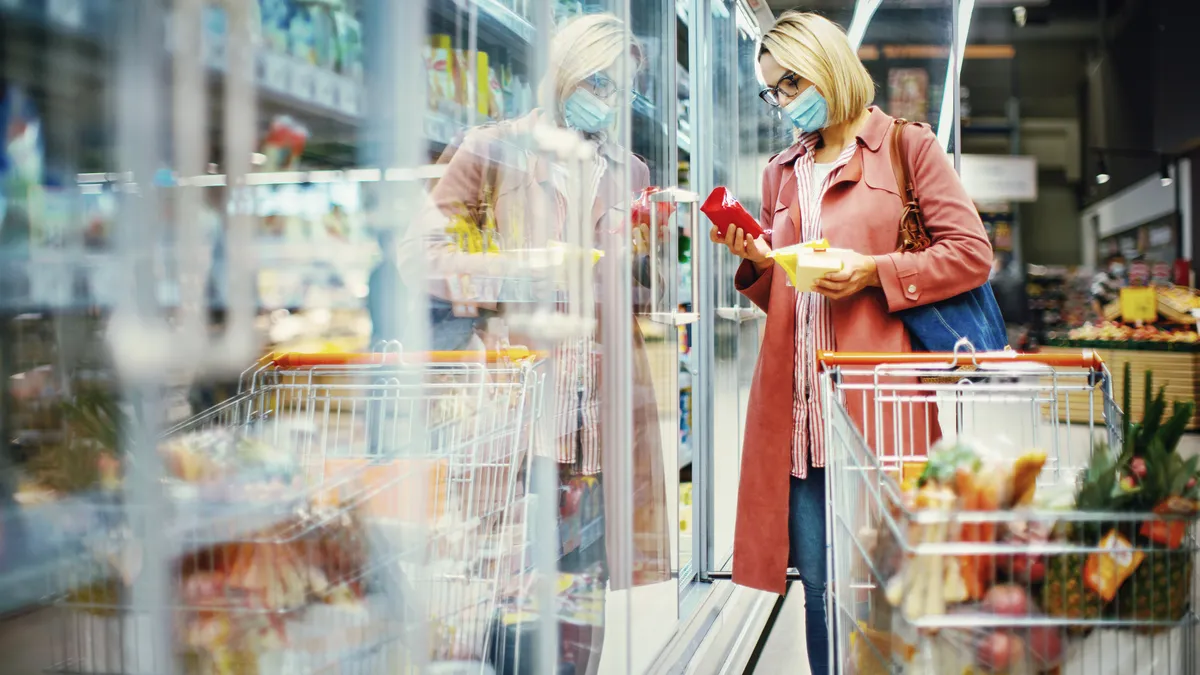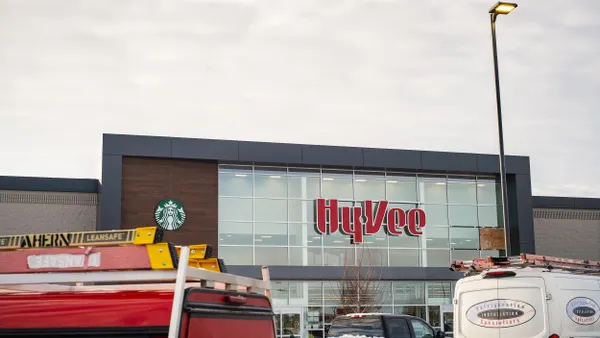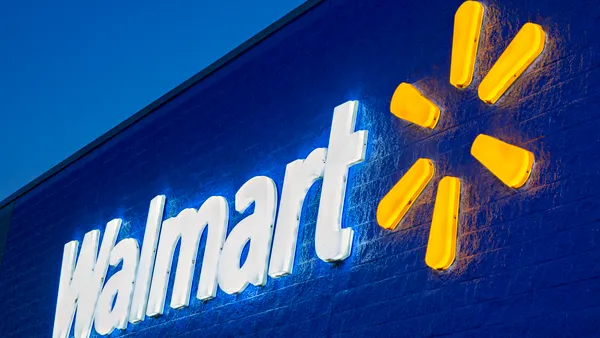Grocers have faced a long list of headwinds so far this year, including supply chain disruptions, high inflation and difficulties hiring and retaining workers. As the halfway mark for the year approaches, these challenges aren't showing signs of letting up.
The continuing turmoil should propel grocers to change their strategies and operations, McKinsey & Company said in its newly released report: “The state of grocery in North America.” For grocers looking to gain advantages in this turbulent landscape, the consulting firm identified five key areas it says company executives need to focus on.
McKinsey’s report is based on surveys earlier this year of 31 grocery CEOs and 25 functional and operations executives; surveys last year of more than 5,000 consumers in the U.S., Mexico and Canada; and analysis and research from the firm.
A common theme throughout the report is that grocers who wait to follow the paths of others or for costs associated with innovation to decrease will be at a disadvantage compared to the ones who press ahead with experimentation to address key challenges.
Here are the top priorities outlined in the new report and by partners at McKinsey in a press briefing earlier this week, along with suggestions from the firm on how grocers can tackle each.
Focusing on value and healthier options
Inflation and the pandemic are prompting shoppers to tighten their grocery wallets, with McKinsey noting that 90% of CEOs expect price sensitivity to continue this year.
But consumers aren’t sidelining their healthy-eating focus, the firm noted. While healthy eating has been tied to natural and organic products, which can carry higher price tags, McKinsey is finding value-conscious shopping is melding with a focus on healthy food, particularly among millennial and Gen Z shoppers.
In looking at the net intent — the difference between the percentage of shoppers who said they would increase and decrease certain shopping behavior, McKinsey found high increases in shoppers' focus in 2022 on saving money (42%) and on healthy eating and nutrition (35%).
Grocers looking to capitalize on this trend can fine tune their value-priced private label lines to have more items tied to health and wellness, the firm suggested.
Expectations rise around omnichannel
Following a spike in grocery e-commerce at the start of the pandemic, McKinsey expects adoption of online grocery shopping to continue, particularly as delivery costs go down and promotions ramp up.
E-commerce plays into consumer demands for convenience, but grocers still have several areas they can improve to make their digital experiences better, the report noted. These include improving user experiences on apps, ramping up loyalty and personalization, and leveraging technology like scan-and-go to blend in-store and digital shopping.
As omnichannel gains traction among retailers such as Walmart and Albertsons, McKinsey said customers want more consistency with their online and in-store experiences in areas like pricing, assortment and promotions.
“To draw more consumers to e-commerce, retailers must offer lower costs, reduce minimum order requirements, protect quality and freshness, and enhance the breadth and discoverability of their assortments,” the report said, noting that omnichannel shoppers spend two to four times more than ones in-store.
Meanwhile, inside stores, grocers can boost the shopping experience by investing in technologies like self-checkout, digital shelf tags and new payment methods, McKinsey said.
Demand heightens for sustainable practices
Grocery CEOs surveyed by McKinsey said they expect shoppers to have a sharper interest in sustainability and factor eco-friendly options into their purchasing decisions.
The consulting firm noted company interest has boomed recently in environmental, social and governance (ESG) initiatives: “Five years ago, Walmart was the only retailer with ESG targets based on public science; today, grocers, apparel manufacturers, quick-service restaurants, and stores of all formats are seeking assistance with their ESG strategies.”
Grocers have yet to fully realize how to commercialize their sustainability endeavors, McKinsey said, but have opportunities to channel eco-friendly efforts toward efficiencies, better margins and growth.
"Only half of retailers that have set sustainability targets expressed confidence that they can actually achieve them," Steve Hoffman, partner at McKinsey, said at the press briefing, noting that the food system, which includes grocers, accounts for around 34% of global emissions.
The firm identified five main areas grocers can focus on in their sustainability efforts: health, the environment, the economy, animal welfare and livelihoods, which includes human rights and fair pay. Additionally, grocers need to find and leverage competitive advantages with their sustainability work, the report said.
“Grocers can generate significant value from a well-positioned sustainability transformation,” the report said, noting ESG initiatives can improve access to capital at better rates and boost favorability among consumers.
As grocers look to establish or improve how ESG efforts tie into their operating models, they first need to assess where they stand on sustainability efforts, set baselines and create targets, McKinsey said. The firm recommends they take a "proactive and holistic view" that makes sustainability a business priority and connects it with the company's vision and strategy and is modeled by top leaders, including the board of directors and CEO.
"Our research has shown us that there is a big rise in the need for more digitally savvy frontline employees as well as people who can think and address the social and emotional skills that come with customer service."

Rahul Mathew
Associate partner, McKinsey
Workforce planning couples with tech investments
The grocery industry employs nearly 3 million people in the U.S., McKinsey noted, but ongoing struggles with hiring and retention coupled with the rising adoption of automation and technology investments are shifting labor needs and reinventing grocery work.
Self-checkout, for example, can boost in-store productivity by 6% to 12%, while artificial intelligence-powered workforce planning and scheduling can provide more accurate predictions of store staffing needs, resulting in a more than 10% savings in labor costs, McKinsey said.
Already, grocers are experimenting with autonomous vehicles and micro-fulfillment centers as they pivot from tech investments as a “wow factor” to essential for driving efficiencies. While automation will replace some jobs, the remaining ones, as a result, will likely change, requiring new skills like digital literacy and understanding of sustainability, and more customer interaction.
McKinsey found that retail hours requiring social and emotional skills and technological skills are expected to increase 32% and 64%, respectively, from 2016 to 2030 in the U.S. and Europe. Meanwhile, total retail hours requiring physical and manual skills are expected to drop by 17%.
Major players are investing in “reskilling” and “upskilling” efforts, like Kroger with its tuition reimbursement program, to make education opportunities more accessible to their workers and grow their internal knowledge of data, analytics and technology, the report noted. Grocers can also improve their employee experience with better pay, benefits and perks; aim to hire in anticipation of trends; grow their digital talent teams; and acquire or partner with companies in order to gain key talent, per the report.
"Our research has shown us that there is a big rise in the need for more digitally savvy frontline employees as well as people who can think and address the social and emotional skills that come with customer service," Rahul Mathew, associate partner at McKinsey, said at the press briefing.
Mathew noted that attrition in grocery jumped last year to roughly 60%, up from the average of 40%, even with around $15 billion of industry spending going toward talent retention. McKinsey research found that grocers, in order to boost retention, need to increase worker's meaning in the workplace and connection with the broader organization, along with growing career development opportunities for them, Mathew said.
Partnerships and ‘ecosystems’ play larger role
As grocers tap more into online shoppers, technology partners will play a greater role in e-commerce operations, the report noted.
"We're seeing a lot of grocers revisit the classic build-by-partner framework. ... Increasingly, people are seeing the benefit of partnerships as a way to get to scale faster, new capabilities faster and oftentimes with less capital investment," Steven Begley, partner at McKinsey, said at the press briefing.
McKinsey expects grocers to team up with delivery companies, link with tech firms to boost their operations and turn to partnerships to create unique value propositions, like Kroger’s prepared meals work with Kitchen United.
Joining forces with tech-savvy players can help grocers roll out strategies more quickly and shoulder the responsibilities that come with innovation. While large retailers will likely work to develop in-house solutions, partnerships make technology accessible to smaller and mid-size grocers.
Following in the footsteps of Amazon and Alibaba, grocers large and small are building out their ecosystems — which McKinsey defines as “an interconnected set of products and services through which customers can fulfill a variety of needs in one integrated experience” — as they look to unlock more revenue streams, according to the report. Companies can strengthen their core grocery business by leveraging loyalty and adding new customers. They can also branch outside of grocery by creating media platforms, moving into grocery-adjacent categories and repositioning as “a technology- and data-enabled platform.”
Ecosystem growth primarily happens through new business-to-consumer verticals and expanding business-to-business services, with several growth opportunities for each, the report noted.












